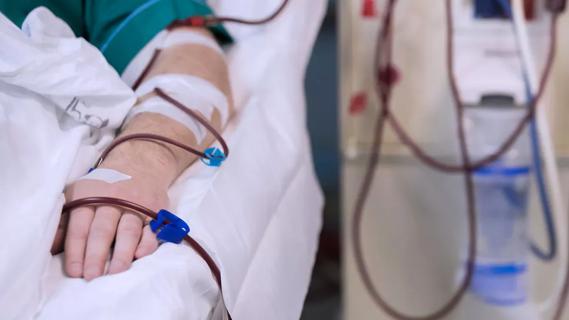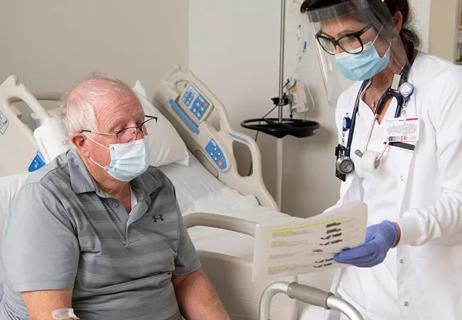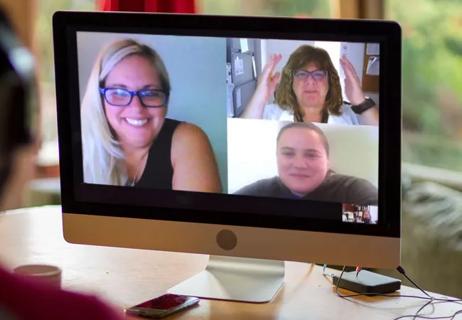Advertisement
The Pause honors patients, caregivers after death

When a patient dies, it’s a difficult time for family and loved ones. But it’s also challenging for the healthcare team – those at the bedside who cared for the patient. To help caregivers in these moments, Cleveland Clinic’s Center for End of Life Care introduced “The Pause,” a 15- to 30-second period of silence at the time of the patient’s death that’s shared by caregivers at the bedside.
Advertisement
Cleveland Clinic is a non-profit academic medical center. Advertising on our site helps support our mission. We do not endorse non-Cleveland Clinic products or services. Policy
Debbie Klein, MSN, APRN, ACNS-BC, CCRN, CHFN, FAHA, a clinical nurse specialist specializing in cardiology, was first introduced to The Pause about five years ago when a fellow in the coronary ICU led one after a patient death following code. “I was amazed by how powerful it was for me as a caregiver,” she says. “It gave me time to honor the person who just died.”
Inspired by her experience, Klein set out to learn more about The Pause, which was created by Jonathan Bartels, BSN, RN, an emergency department nurse and palliative care liaison nurse from the University of Virginia Medical Center. Klein now co-chairs the Center for End of Life Care’s Pause Committee along with Christine Traul, MD, and is part of the team that helped introduce Cleveland Clinic’s version of The Pause to caregivers in the healthcare organization.
Treating patients in their last hours can be an intense experience, which is why Klein felt strongly about bringing The Pause to Cleveland Clinic caregivers. “We need to remember to take care of ourselves as well as the patients,” she says.
The Center for End of Life Care has three objectives: respect patients’ preferences, improve the family experience and foster the healthcare team’s resilience. The Pause has been implemented to cultivate caregiver resilience in caring for dying patients. Though it’s designed for caregivers, the patient’s family members and loved ones who are present are welcome to join in.
Participation in The Pause is voluntary. It’s usually performed at the bedside, but it can be done at another location. The idea is to do it as soon as possible after the time of death is called.
The Pause is not a debriefing of medical events, nor is it a time of prayer or religious practice. It is simply a time to honor everyone present and reset. “It’s a way to honor the human life that was lost and the team that cared for that person,” says Klein. “And it helps provide closure for the caregivers, preparing the team to take care of future patients.”
A physician or nurse initiates The Pause using a suggested script:
“Let us take a moment to pause and honor [patient’s name]. He/she was someone who loved and was loved – was someone’s family member and friend. In our own way and in silence, let us take a moment to honor [patient’s name]. Let us also honor and recognize the care provided by our team.”
15 – 30 seconds of silence.
“Thank you, everyone.”
Advertisement
If family members are at the bedside and wish to participate, the caregiver explains the purpose of The Pause. The caregiver also may provide anyone present with a card containing a description of The Pause, as well as the script. The Pause cards, which are now included in all emergency carts on Cleveland Clinic’s main campus, are available in English, Spanish, Arabic, Russian, Mandarin and Cantonese.
The Pause was piloted at various locations at main campus and Cleveland Clinic’s Hillcrest Hospital, then began rolling out across the healthcare organization. The goal is to bring The Pause to all Cleveland Clinic locations this year.
“The Pause can be hard to lead because you’re feeling the emotion,” says Klein. “But once you do, you can feel the impact that it has.”
Advertisement
Advertisement

Clinicians prepare to deliver lifesaving care in the face of public health threats

Phone triage system reduces call backs and delays in care

New protocol reduces costs, increases patient and caregiver satisfaction

New options benefit caregivers, nursing units and patients

Nurses facilitate preoperative program to educate and prepare patients for ongoing care

Introduces at-home work and new patient screening tool

Health disparities, mental health and more

Ideas for approaches to prevention, response and more